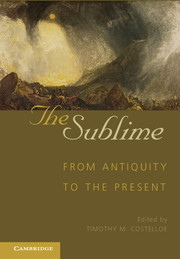Book contents
- Frontmatter
- Contents
- List of Illustrations
- Contributors
- Acknowledgments
- The Sublime
- Part One Philosophical History of the Sublime
- 1 Longinus and the Ancient Sublime
- 2 … And the Beautiful?
- 3 The Moral Source of the Kantian Sublime
- 4 Imagination and Internal Sense
- 5 The Associative Sublime
- 6 The “Prehistory” of the Sublime in Early Modern France
- 7 The German Sublime After Kant
- 8 The Postmodern Sublime
- Part Two Disciplinary and other Perspectives
- 10 The First American Sublime
- 11 The Environmental Sublime
- 12 Religion and the Sublime
- 13 The British Romantic Sublime
- 14 The Sublime and the Fine Arts
- 15 Architecture and the Sublime
- Bibliography
- Index
- References
7 - The German Sublime After Kant
Published online by Cambridge University Press: 05 January 2015
- Frontmatter
- Contents
- List of Illustrations
- Contributors
- Acknowledgments
- The Sublime
- Part One Philosophical History of the Sublime
- 1 Longinus and the Ancient Sublime
- 2 … And the Beautiful?
- 3 The Moral Source of the Kantian Sublime
- 4 Imagination and Internal Sense
- 5 The Associative Sublime
- 6 The “Prehistory” of the Sublime in Early Modern France
- 7 The German Sublime After Kant
- 8 The Postmodern Sublime
- Part Two Disciplinary and other Perspectives
- 10 The First American Sublime
- 11 The Environmental Sublime
- 12 Religion and the Sublime
- 13 The British Romantic Sublime
- 14 The Sublime and the Fine Arts
- 15 Architecture and the Sublime
- Bibliography
- Index
- References
Summary
INTRODUCTION
Immanuel Kant’s account of the sublime used the framework of earlier eighteenth-century theories, but it radically interiorized or, to use Hans-Georg Gadamer’s term, subjectivized them: whereas most theorists, whether German or British, characterized the experience of the sublime as our emotional response to the magnitude and power of nature and to exemplary cases of human morality, Kant explained the complex feeling of this experience as a response to the limits of our own imagination, and the power of our own theoretical and practical reason. Kant reduced the natural objects other theorists took as the proper object of the experience to mere triggers, the proper object of the experience being ourselves.
Friedrich von Schiller’s influential essays on the sublime from the middle of the 1790s largely followed Kant, but after him the “absolute idealists” Friedrich Wilhelm Joseph Schelling and Georg Friedrich Wilhelm Hegel reverted to an objectivist approach that interpreted sublimity as the response to the magnitude or infinitude of realities beyond our own mental faculties. These philosophers interpreted both beauty and sublimity as sensible manifestations of reality and thus effaced the sharp line Kant had drawn between the beautiful and the sublime and, particularly in the case of Hegel, treated the sublime as an early stage in the two categories. They still considered reality to be inherently rational, however, and so maintained the general connection between sublimity and rationality that Kant had pioneered. Arthur Schopenhauer, by contrast, was convinced that reality was nonrational and, consequently, turned the sublime into an experience of natural beauty achieved in the face of nature’s hostility to individual existence. Schopenhauer’s reinterpretation of the sublime along these lines was subsequently turned back into a category of art by the young Friedrich Nietzsche, even though he based his conception of the relation between the Apollonian and the Dionysian in The Birth of Tragedy on Schopenhauer’s view that individual rationality is a veneer placed over the underlying nonrationality of existence. In Nietzsche’s hands the sublime becomes an experience of the transcendence of rationality rather than of transcendent rationality but remains, as it had for Kant, an affirmative experience: in what he would later call the “transvaluation of values,” Nietzsche sees human redemption in transcending the limits of individual reason and identifying with the absurd and contradictory character of existence. Nietzsche, in effect, returns the sublime to the position of importance that it had enjoyed under Kant and Schiller but gradually lost in the work of Schelling, Hegel, and Schopenhauer.
Information
- Type
- Chapter
- Information
- The SublimeFrom Antiquity to the Present, pp. 102 - 117Publisher: Cambridge University PressPrint publication year: 2012
References
Accessibility standard: Unknown
Why this information is here
This section outlines the accessibility features of this content - including support for screen readers, full keyboard navigation and high-contrast display options. This may not be relevant for you.Accessibility Information
- 7
- Cited by
